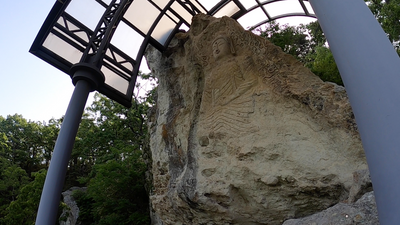Sleepover at a Korean Temple | My Birthday Weekend Templestay
- Ali Rose

- Jun 16, 2021
- 10 min read
Friday, May 7
Happy birthday to me! I woke up earlier than usual today to call my amazing mother and open the gifts she sent me. It really made my day incredible from the very beginning. Work and fifth grade classes were uneventful. After school, I took a bike to the train station and got up to Gyeongju at around 6pm. I walked around the area by all the tomb mounds while waiting for my friend to arrive. The fine dust wasn't great today but the weather was gorgeous and everyone seemed to be out enjoying the evening. I met up with Christy and we headed in the direction of a place I knew to have a lot of cool restaurants. We sat outside and shared lasagna and cream pasta. The vibes in this area are so chill and cozy, sitting next to the fire heater surrounded by renovated hanok restaurants on the pedestrian-only street. After, we cross the street to a hanok cafe and get a slice of oreo and chocolate cake. We don't have candles, but I make a wish anyway and we chill until closing time.
Saturday, May 8
We sleep in a bit today, check out at 11, and wait for two more of my friends to arrive. For brunch, everyone orders french toast and bacon, and we eat our fill since we won't be able to snack at all before dinner. We pick up our bags and get a 40 minute cab to Golgulsa Temple for our templestay. This program is open at many temples here for both Koreans and foreigners to get a glimpse of daily temple life. The drive there is mostly through the countryside surrounded by nature and mountains. Soon we're pulling up past statues of martial arts poses and under the gate. We check in at the office at 1pm, go over some info, and receive our sheets, uniform, and room key. Luckily there are a few English speakers at this temple so the whole program is in English. We cross the road and drop off our bags in our room. It's Korean-style with no furniture and a floor mattress, but modern in that there's heating and a full bathroom. Christy and I share a room and my two other friends share the one next to us. We all attempt to change into the temple pants and vest combo together. They're incredibly baggy and kind of difficult to tie but soon we're outfitted in our best monk-chic. This is also the point where I turn my phone off. I figure this little experience will be best without any connection to the outside world. Our first schedule is at 2 - meditation. First we sit in half-lotus posture, like criss-cross applesauce but with your right foot on top of your left leg. Then we do a little side stretch, put our hands in cosmic mudra position, and learn "samtosik" - 3 deep breaths. Make sure to do the "tssssssss~" sound when exhaling. From there we go into 20 minutes of meditation which felt way shorter than I expected. I don't think I quite found my true nature but it was very calming nonetheless.
Then we make the incredibly long 20 minute walk up the mountain to the main temple. When I tell you my legs were burning by the end of this weekend, it's not an exaggeration. There we get a glimpse of the temple itself and Golgulsa's main draw and namesake. "Gol" means "skull" and "gul" means "cave" which seems like too cool a name for a temple. Because the type of rock weathers in such an interesting way, the holes and caves look almost skull-like. A giant buddha is carved at the top of the rock face, dating back 1500 years when the temple was first built. The temple itself had burned down many years ago and wasn't rebuilt until around 1985. Regardless, it's an impressive spread and nice treat for the difficult walk up. There we watch a sunmudo demonstration. Golgulsa is home to this "zen martial art" which utilizes poses and breathing more than actual fighting. Back in the day, only monks were allowed to practice it and only recently did they begin teaching it to the general public. Here, we see some sunmudo, dancing, and traditional singing.
Community work is in the schedule next, but they inform us there isn't any today, so we take the opportunity to walk about the cliff side. Now there are railings along all the drop offs, but we couldn't imagine how scary it'd be to walk here before them. There are also so many colorful lanterns hanging all around the temple for Buddha's Day coming up in a few weeks. Soon we make the trek all the way back down the hill to ring the bell before dinner. I'm surprised when the guide encourages us to put either our hands, our foreheads, or our whole bodies up against the bell while the others ring it. It's cool to feel it reverberate through my body. Then we walk over to the cafeteria for dinner at 5:30. Before entering any building here you must take off your shoes, even in the cafeteria. We pick up food buffet-style - rice, salad, kimchi, radish, soup, vegetables, apples, etc. All vegetarian, of course. We have to be careful to get only a small portion of food - you can go back for seconds but you have to eat everything you put on your plate. We grab a floor cushion, sit at the low tables, and dig in. Usually meals at temples are silent but our guide said this one's more relaxed so we could chat quietly.
After dinner (and washing our own dishes), we go to orientation. There, the instructor teaches us a bit about temple etiquette. We learn how to bow properly, greet others staying/working here, say the main chant (Namu amitabul - Return to Buddha), and play the moktak - a fish shaped drum. These we'll all be doing at chanting in the morning. We also ask why the instructor, a young French guy, would come to live here. He came to train in sunmudo then actually liked Buddhism a lot and decided to stay. We then transition to evening chanting service. The women sit on the left, men on the right. Before sitting, make three prostrations. Bow 90 degrees, kneel, touch hands and forehead to the floor, face palms upwards, kneel, and stand again. On the last one, instead of facing palms up, bring prayer hands under your forehead. Then the chanting begins. We follow the actions of everyone else - bowing, kneeling, and standing regularly. It's all very interesting and kind of weird, but for me I just see these actions as showing respect to someone else's beliefs even though I don't practice them myself. It's definitely cool to see so deeply into some people's ways of life and experiencing a part of so many Koreans' culture. In addition to a religion, many Koreans view Buddhism as more of a philosophy or simply just a part of their culture.
Then, we spread out and start some sunmudo training. It begins with what I'd liken to fast paced stretching and pilates warm up exercises. We're all feeling it by the time we put the cushions away - I just know my abs are going to be burning tomorrow. Now we take a couple laps around the room, jogging, grapevines, bear crawls, push ups, etc. It feels pretty intense, especially for how out of shape I am. The trainer then runs to the deck outside. It's a cool night so the air feels nice. After a couple small laps here we stop and he demonstrates the three most basic sunmudo techniques. It's all very focused on breathing, slow, with a lot of body control needed. First, inhale, sweep your hands upward in front of you and over your head while bending backward at the waist. Exhale, bring your hands down by your neck and forward, pushing fingers spread in front of you while squatting. Repeat. The other two techniques are similar and involve bending to the right and left. It seems easy at first but my abs are dying and the instructor makes it look so effortless.
It's now around 9pm so they send us off to bed. We debate hiking back up the hill to see the lanterns lit up at night but decide it'd be better to rest well for our early morning tomorrow. We unfold and set up our beds and set a 5:10 alarm in case the speakers don't wake us up at 5.
Sunday, May 9
I sleep on and off, mostly because I'm scared about oversleeping. I even have a stress-dream that I show up like an hour late. Now, I turn on my phone to check the time - 4:59 - perfect. A minute later, soft chanting filters in from the speakers outside. It's quieter than I expected and not enough to wake Christy. At 5:10 we quickly pull on our temple garb and speed walk as best we can up the hill to the chanting room below the temple. The sun is up already, the birds are out, and it's an incredibly peaceful walk despite the early hour. At the top, the morning sun bathes the temple and cliff in a beautiful soft light. We take off our shoes and enter, picking up a lyrics sheet and moktak and sitting on the left. To my surprise and delight, a tiny white puppy is running around inside! It's absolutely adorable. One of the monks picks it up and brings it back to the front of the room. They sit together until the puppy gets bored and wanders around again. Apparently this puppy is the newest in the line of temple dogs that live here and we've seen a couple other dogs here too. There's even a statue of the first one along the path up here. It's so cute seeing the monks playing with them. Anyway, the morning chanting starts and there's lots of standing and kneeling and bowing. About halfway through we all pick up our fish drums and follow along with the tempo.
At 5:30 we go back outside and farther up the hill for sitting meditation outside. It's so peaceful with the morning breeze and birds singing. This is one practice I can totally get behind. While traveling so much and trying to fit everything possible in the day, especially in Korea's balli balli (fast fast) culture, it's easy to forget to just sit somewhere and soak everything in. I don't know if i'll have the motivation to meditate much after this weekend, but I really would like to try to pause every now and then and think about where I am, what I'm doing, and take in the beauty before me. After 20 minutes we transition into walking meditation. I didn't know this was a thing but we line up, hands clasped in front of us, take a couple slow laps around the pillar representing the chakras, and then make our way down the mountain to breakfast at 7am. The meal is similar to dinner except this one comes with fruit in yogurt and a different soup.
We get an hour of free time after, so Christy and I walk a long way back up the mountain (we're crazy I guess) to get some fresh mountain water from the well. It's good and really minerally but I'm exhausted. On our way back down we have a long deep talk about religion, life, death, etc. You know, just your average post-breakfast temple conversation. There's a pond by our next destination so we chill there for a while just chatting and finding peace in the nature. It's so nice escaping the city and being surrounded by nature. I'm not even really missing my phone at all.
At 8:30 we go inside the tea room for tea time with one of the monks. After apologizing that we can't use real teacups because of corona, our guide/translator says the floor is basically open to ask questions and chat. The monk is really nice and tries to answer our questions as best he can despite the language barrier and abstract topics. The questions start simple and increasingly get more complex. Can you use technology? Only for work. Can you leave/visit your family? Very rarely. Can you marry? No. Why did you become a monk? I remember he said he was mid-twenties when he left his old life behind to join this monastery. It's hard for me to imagine that someone so young would choose this kind of life, but it seems he really had a true calling and found his purpose in life. It was nice to see him becoming more talkative with these deeper questions. What is enlightenment? Well, it's difficult to explain. The example given is that it's when you acknowledge that there is suffering in the world, but realize that suffering does not exist, same with happiness and other emotions and things. (Complicated? Uh yeah.) Well then does enlightenment then discount how people are suffering around the world? Well no, because part of being Buddhist is living a moral life, helping others, and showing compassion. One of our rules here is to respect even the lives of the insects on the ground that we could step on if we're not careful. Even though it's all a bit confusing, the translator does her best to explain it all to us and even apologizes a few times afterward. The talk goes on for an hour, but we all wish we had a bit more time for questions.
Immediately after, the 108 prostrations start in the meditation room. We guiltily (and purposefully...) arrive a few minutes late. Hey, they did give us permission to. These 108 bows are the ones we did in chanting but one immediately after the other without stopping 108 times. Bow 90 degrees, kneel, touch hands and forehead to the floor, face palms upwards, kneel, and stand again. The cushions are soft but my god this is difficult. The first half is easy, but my body gets slower and slower and my thighs are burning. Well, why so many bows? The 108 prostrations represent our basic mental sufferings. Take the 6 combinations of sense organs (eyes, ears, nose, tongue, body, mind) and sense objects (color, sound, smell, taste, touch, concept) and multiply by the 3 reactions (likes, dislikes, neutral feeling, which turn to joy, sorrow, and indifference) to equal 36. Then multiply this by 3 for the past, present, and future, giving us 108. Apparently, these bows help to sublimate and purify, connecting mind and body, and breaking the cycle of 108 sufferings. However, by the time the last bow finishes, I'm feeling just about dead. My friends counted and think we got to around 80. I can't imagine doing all of them. You've gotta be really fit to be a monk.
It's about 10am now with nothing on the schedule until lunch at noon and then check out, so we decide to leave early and spend a little time in Gyeongju before going home. We change back into our street clothes, pack up, hand in our sheets and keys, and I finally turn my phone on after 24 hours without it. We call a cab and head back into the city. We get brunch and delicious soft serve ice cream before taking a train back home. It was certainly an ~enlightening~ weekend where I learned a lot and had some fun too, truly an immersive cultural experience.
Thanks for reading! Check out my video below!
























































































































































Comments